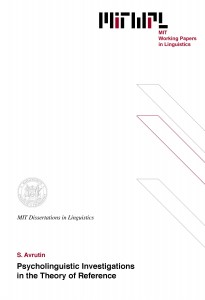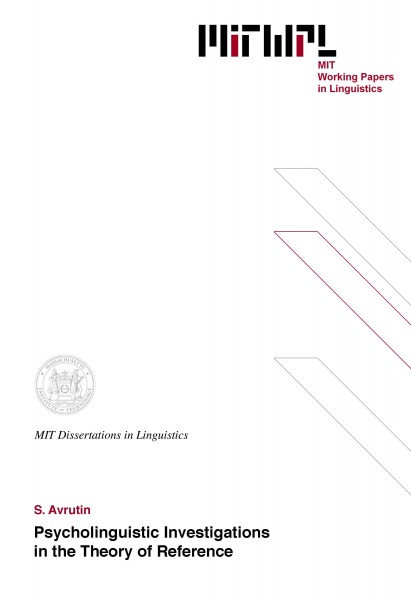Psycholinguistic Investigations in the Theory of Reference
S. Avrutin, 1994
The correct use of pronominals requires knowledge of both syntactic and discourse related principles. Normal adult speakers, in most cases, are able to fluently use and immediately understand pronominals, although the interpretation of these elements is different from one use to another. The pronoun she, for example, can be used to talk about an infinite number of singular female individuals, yet speakers (in most cases) are able to interpret it as designating one particular person. Establishing a unique reference for a pronoun depends on taking into account both syntactic and discourse information. Thus, the integration of the knowledge of syntactic and discourse-related principles appears to be a natural capacity of normal adult speakers.
Part I of this thesis presents a model of the syntax-discourse interface that shows how the syntactic and discourse-related information is coordinated in order to establish reference for definite noun phrases, pronouns in particular. It is argued that the integration of two types of knowledge is required: the speaker-internal knowledge and the conversation-internal knowledge. The proposed model explains certain errors in pronominal interpretation observed in young children. Children have difficulties implementing conversation-internal knowledge because it requires making inferences about other speakers’ representations of the discourse. Based on the results reported in the literature, it is argued that children’s inferential capacity is limited. It is proposed that these limitations lead to specific errors in children’s interpretation of pronouns. It is further suggested that the same types of limitations explain similar errors observed in Broca’s aphasics.
Part II presents theoretical and experimental projects that investigated children’s knowledge of pronoun distribution in various constructions (Russian possessives, English plural pronouns, pronouns in Russian subjunctive clauses). Consistently with previous findings, in those constructions where the correct interpretation of pronominals requires only the speaker-internal knowledge (i.e. syntactic principles), children’s performance is almost no different from that of normal adults. In cases where the correct interpretation requires additional inferential resources, children’s performance deteriorates significantly.
Overall, the theory and experiments presented in this thesis argue for a modular account of linguistic development and breakdown. It is argued that the relevant linguistic knowledge is available to young children and intact in Broca’s aphasics, while their capacity to implement (at least part of) this knowledge is limited.
Thesis Supervisor: Kenneth Wexler, Professor of Psychology and Linguistics
| Introduction | 8 | ||
| Part I: Establishing Reference | |||
| 1 | Pronominals in adult and child speech | ||
| 1.1 | Pronominals in natural language | 11 | |
| 1.2 | Previous acquisition results | 18 | |
| 2 | Syntax, discourse and interpretation of pronominals | ||
| 2.1 | General model | 26 | |
| 2.2 | Syntactic constraints and interpretation of indices | 28 | |
| 2.3 | File change semantics | 35 | |
| 2.4 | Interpretation of indices in syntax and discourse | 37 | |
| 2.5 | Various uses of definite NPs | 44 | |
| 2.6 | Incorporation and accommodation | 48 | |
| 2.7 | Constraints on bridging | 56 | |
| 3 | Children’s and aphasics’ results revisited | ||
| 3.1 | Principle A and Principle B constructions | 61 | |
| 3.2 | Good performance with pronouns | 68 | |
| 3.3 | Weak pronouns | 73 | |
| 3.4 | Principle C constructions | 77 | |
| 4 | Experimental evidence reported in the literature | ||
| 4.1 | Experimental evidence for the existence of two different mechanisms: incorporation and accommodation | 80 | |
| 4.2 | Deictic use of definite NPs in children’s discourse | 84 | |
| 4.2.1 | Pronominalization in children’s discourse | 84 | |
| 4.2.2 | Children’s use of R-expressions | 85 | |
| 4.3 | Children’s and aphasics’ inferential capacity: more experimental evidence | 89 | |
| Part II: Theoretical and Experimental Projects | |||
| 5 | Possessive pronouns and reflexives in Russian | ||
| 5.1 | Overview of Russian possessives | 95 | |
| 5.2 | Distributive and collective readings of plural pronouns | 96 | |
| 5.3 | Anti-subject orientation of singular pronouns | 102 | |
| 5.4 | Definite NP antecedents | 106 | |
| 5.5 | Non-local binding | 111 | |
| 5.5.1 | Quantified NP antecedents | 111 | |
| 5.5.2 | Plural NPs | 115 | |
| 5.6 | English possessive pronouns | 117 | |
| 5.7 | Conclusions | 120 | |
| 5.8 | Children’s knowledge of the distribution of pronominals in Russian | 121 | |
| 6 | Plural pronouns | ||
| 6.1 | Distributivity and binding in child grammar | 129 | |
| 6.2 | Plural pronouns | 132 | |
| 6.3 | Experiment | 134 | |
| 6.4 | Results | 136 | |
| 6.5 | Conclusions | 138 | |
| 7 | Pronouns in subjunctive clauses | ||
| 7.1 | The disjoint reference requirement in Russian subjunctive clauses | 139 | |
| 7.2 | Previous accounts | 140 | |
| 7.3 | Summary | 146 | |
| 7.4 | V-to-I-to-C movement and pronominal Agr | 147 | |
| 7.5 | Theoretical conclusions | 159 | |
| 7.6 | Children’s knowledge of the obviation in subjunctive clauses | 160 | |
| 7.6.1 | Previous results | 160 | |
| 7.6.2 | Theoretical background and experimental design | 163 | |
| 7.6.3 | Experiment | 168 | |
| 7.6.4 | Results | 170 | |
| 7.6.5 | Discussion | 174 | |
| 7.6.6 | A note on learnability: null subjects and obviation | 181 | |
| 7.6.7 | Conclusions | 184 | |

